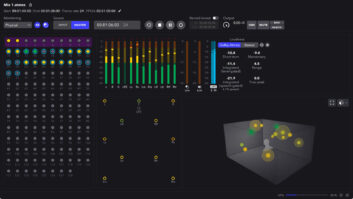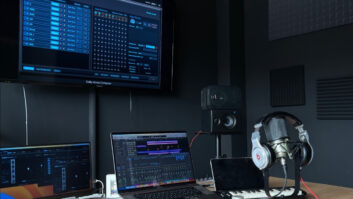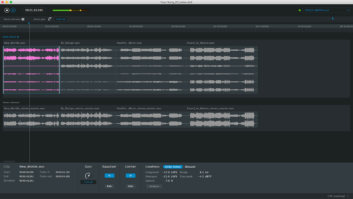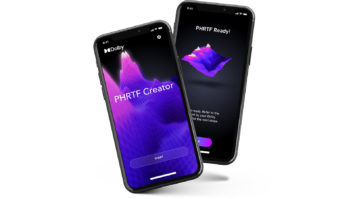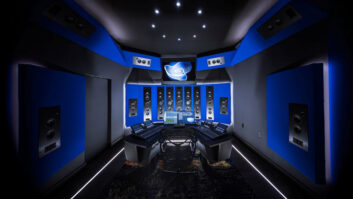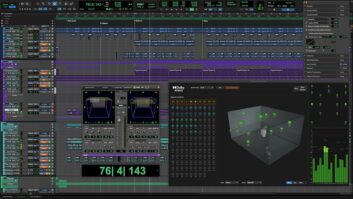This story, sponsored by Dolby, appeared in the August 2018 issue of Mix magazine.
It all started with a panner. A few years ago, Cheryl Ottenritter was working on a 16.2.2 custom mix for the American Revolution Museum at Yorktown in Williamsburg, Va., and knew that along with rump-shakers, wind, scent and five 4K projectors, the director would want a lot of overhead sounds in re-creating the Siege of Yorktown. She was mixing on-site, and Pro Tools at the time didn’t include the Dolby Atmos integration. So she called Tom McAndrew at Dolby and asked, “Do you have a panner I can use?”
Tools were at the edge of release at Dolby at the time, about to break open, and Ottenritter didn’t get her panner in time for the job. She got something better. “They interviewed me and put me in the beta program for the RMU that they put in the rooms,” she says. “I was one of the early ones to get that RMU, and it all started with a call about a panner.”
Just a few short years after that, in October 2017, Ottenritter opened a “near-field” 7.1.4 Dolby Atmos suite in her 2,700-square-foot Silver Springs, Md., facility, the first of its kind in Washington, D.C.’s large (and underreported) audio post-production market. And she and her team at Ott House are about to build two more.
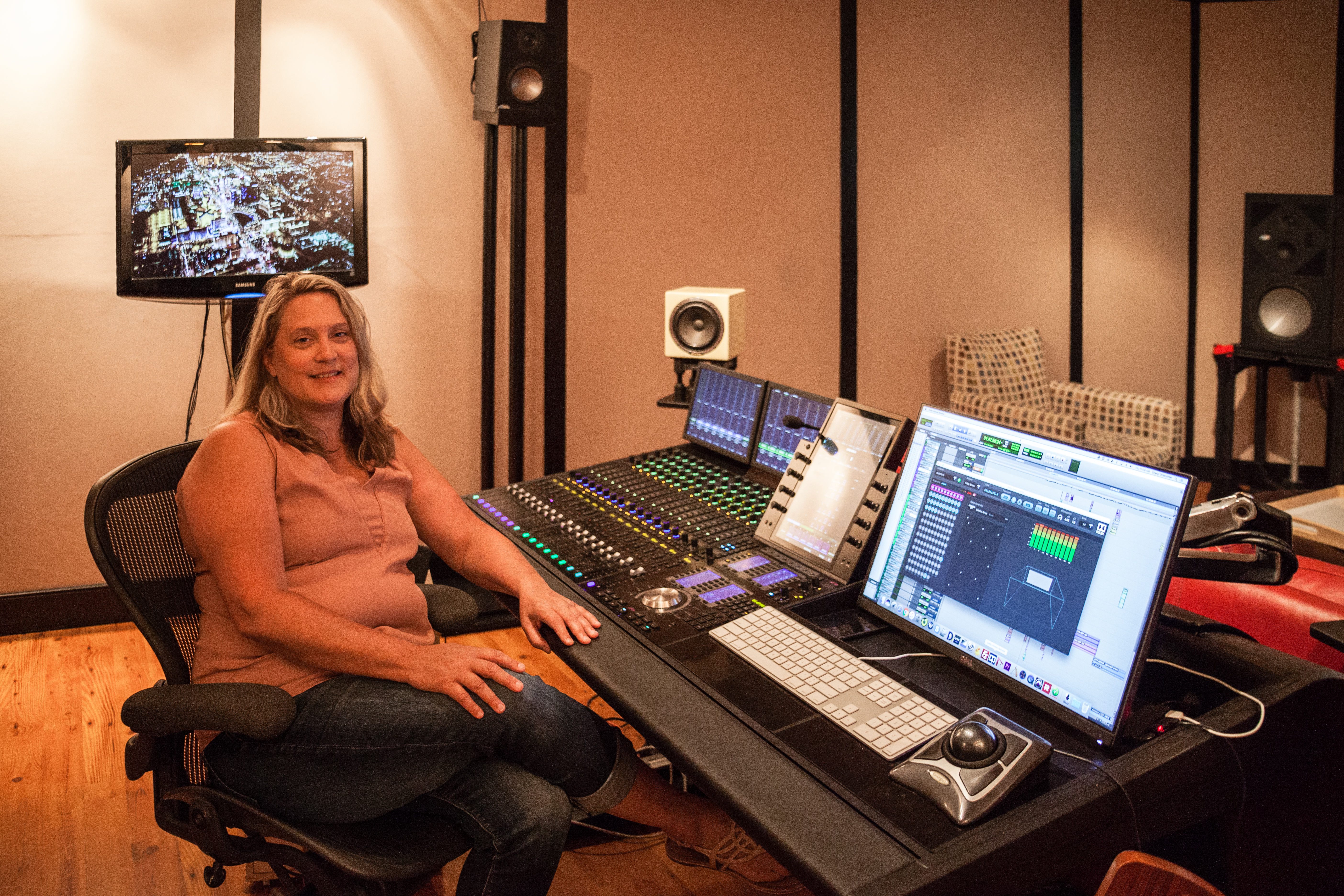
“I think that within two years, Atmos delivery will be a requirement for all original programming,” Ottenritter says. “I didn’t want to be in the position of learning it and playing catch-up. I wanted to be ahead and get the quirks out. It’s a totally different workflow. There are parallels, but it’s object-based—a different workflow.
“If you’re building a room, why would you not build an Atmos room?” she continues. “You already have to build 5.1 or 7.1, so why not? If it’s money that’s the issue, wait on buying the RMU. But get the tools, start getting used to the workflow, play around with it, so that when somebody calls, you’re there. If you’re in this world and thinking about Atmos, you know you’ll need it shortly if you want to keep working on certain projects. It’s really not that much more than putting in a 5.1 room.”
Ottenritter is no newbie to new technologies. She embraces them. A double music major at Auburn University, she started out as a composer, falling in to engineering as a way to put her music to picture. Soon she realized she liked sound design and took an entry-level job in the machine room at Henninger Media Services. Mix work followed, then four years in New York City working on national spots, then back to D.C. to raise a family. There, she opened her own shop in 2006 with a contract and support from one of her key clients, TV One, a network she helped launch, sound-wise. She still has that contract.
Dolby Atmos: The Business and the Technology, by Steve Harvey, July 9, 2018
Along the way, and always self-taught, she watched the industry evolve from writing on pen and paper to working on the first WaveFrame, then AudioFile, Cubase—“That got me into engineering,” she says—and every new emerging platform or technology. She visited the Mix Presents Sound for Film: Immersive Audio conference at Sony in 2013 and was “blown away. I thought right away that this is the future of audio.” She started thinking about how to do it, judging the size of her room, and opened for Immersive last October, adding an Avid S6 to replace her D-Command.
“We did it all ourselves, with our engineering team,” she explains, giving kudos to her team of John Ottenritter, Jeremy Guyre, Alex Roldan and Rick Rush. “Jeremy Guyre spearheaded the adventure for us and put together a fantastic-sounding room. He also did the integration work.
“We put in just two sets of overheads onto a pure 7.1 system,” she continues. “Atmos works really well in the near-field environment; it’s very immersive. You definitely feel that pan and the placement of the voices, or when you spread the music. It doesn’t have to be in a huge environment. We did six features last year 5.1 to Atmos for streaming, and we got really good feedback on them. More and more it’s going to be the independents in these smaller and mid-sized rooms, and they’ll go to the theatrical dub stages to finish.”
The Dolby Atmos room at Ott House currently houses a five-knob, 16-fader Avid S6 M40 with touchscreen monitor panel, a Blue Sky SAT12 and 6.5 monitor system, with Monitor Audio CP-CT260 ceiling speakers and DAD conversion with MADI and Dante cards. The two new Atmos rooms, expected to open in October and November, will be across town from one another—one planned for the 1,400-square-foot basement in her newly built home, the other in a new facility she is building in coordination with her color grading partner (and Dolby Vision operator) Robbie Carman. She is also building home suites for her mixers, and she’s investing in streaming technologies.
Want more stories like this? Subscribe to our newsletter and get it delivered right to your inbox.
“The client facility will house the RMU, and we will use that for printing, with the Atmos-Pro Tools integration in the other rooms feeding that,” Ottenritter explains. “We want to be location-agnostic. We’ve invested in a Streambox Chroma with 4K option and 7.1 surround for remote live review with clients, and Atmos is supposed to be coming in the next upgrade. The streaming is exciting. The latency is only 1 to 2 frames, and we’ll be working on a documentary this fall streaming preliminary mixes to the client remote. We also have a shared Small Tree SAN, and we will share assets over VPN, with total security.
“I don’t downplay that a lot of the work we do is really played in stereo,” she concludes. “Even on a tablet in mono. But the consumer gear for Atmos is proliferating, and it’s going to snowball. Netflix is helping that happen. Apple, Amazon. You don’t want to be late to the party. Be ready for it.”
Ott House • otthouseaudio.com • Twitter @otthouseaudio
Dolby Atmos • www.dolby.com/us/en/brands/dolby-atmos.html
This story, sponsored by Dolby, appeared in the August 2018 issue of Mix magazine.
